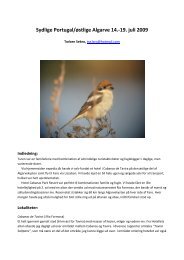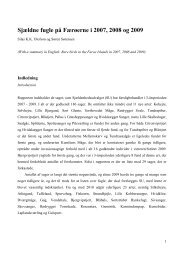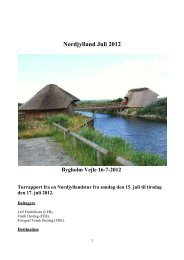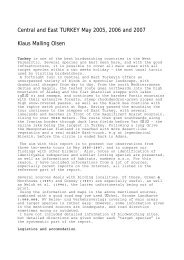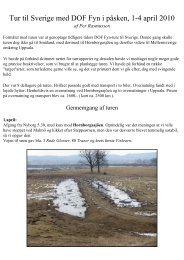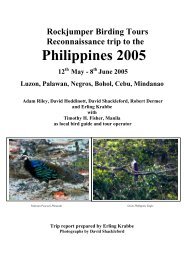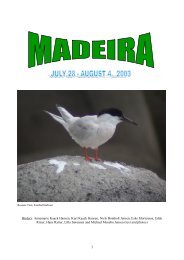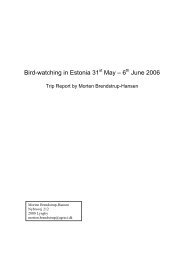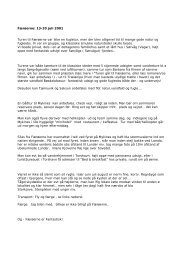NE Tibet with OBC, 3-20 August 2005 - Netfugl.dk
NE Tibet with OBC, 3-20 August 2005 - Netfugl.dk
NE Tibet with OBC, 3-20 August 2005 - Netfugl.dk
Create successful ePaper yourself
Turn your PDF publications into a flip-book with our unique Google optimized e-Paper software.
<strong>NE</strong> <strong>Tibet</strong> <strong>with</strong> <strong>OBC</strong>, 25 May – 14 June <strong>20</strong>08.<br />
An at-a-glance list of 229 species of birds & 22+ species of mammals.<br />
By Jesper Hornskov<br />
[this draft 18 June <strong>20</strong>08]<br />
Please note that the following list is best considered a work in progress. It should not be quoted <strong>with</strong>out<br />
consulting the author.<br />
This brief write-up covers the birds & mammals noted by J Adamson, N Birch, R Birch,<br />
P French, A Kelly, J Newman, D O'Mahony, J Penhallurick, A Short, B short & myself<br />
during the <strong>20</strong>08 <strong>OBC</strong> Fundraiser trip.<br />
Thank you all for making this trip so enjoyable, and thank you for, by joining,<br />
contributing to <strong>OBC</strong>’s Conservation Fund. Special thanks are due to Michael<br />
Edgecombe for volunteering to coordinate.<br />
Anyone considering China as a birding destination is welcome to contact the author at:<br />
Tel/fax +86 10 8490 9562 / mobile +86 135 1335 9831<br />
E-mail goodbird(at)vip.sina.com or goodbirdmail(at)126.com<br />
In the species list the concept "bird-days" is used - it is the avian equivalent of manhours:<br />
for example, separate flocks of ten and 15 Henri’s Snowfinches moving through<br />
score 25 bird-days, as would the same single individual seen daily for 25 days. The sum<br />
of day totals - a handy measure of relative abundance, nothing more.<br />
The sequence of the bird list follows The Howard and Moore Complete Checklist of<br />
the Birds of the World – 3 rd Edition (Dickinson <strong>20</strong>03), in my opinion by far the most<br />
useful one-volume checklist to date.<br />
Initials in brackets after a few single-observer sightings does not imply that I have<br />
doubts as to the correctness of the ID.
BIRDS:<br />
Severtzov’s Hazel Grouse Tetrastes sewerzowi<br />
Five bird-days. At Nangqian forest reserve four (two pairs) intermittently showing well on 6 th &<br />
one briefly [PF] on 8 th .<br />
Szechenyi’s Monal Partridge Tetraophasis szechenyi<br />
24+ bird-days. Noted on three dates. Extended views of two at close range (
Whooper Swan Cygnus cygnus<br />
Three bird-days. An incubating bird was seen on two dates; on the 1 st occasion its presumed<br />
partner was present nearby.<br />
Common Shelduck Tadorna tadorna<br />
c15 bird-days. Noted at Koko Nor on two dates.<br />
Ruddy Shelduck Tadorna ferruginea<br />
298+ bird-days. Noted on 14 dates.<br />
Gadwall Anas strepera<br />
15 bird-days. Noted at Koko Nor on two dates.<br />
Eurasian Wigeon Anas penelope<br />
30+ bird-days. Noted on three dates: at Koko Nor & S of Maduo.<br />
Mallard Anas platyrhynchos<br />
c35 bird-days. Noted on two dates at Koko Nor.<br />
Chinese Spotbill Anas zonorhyncha<br />
12 bird-days. Noted on three dates.<br />
Northern Shoveler Anas clypeata<br />
24 bird-days. Noted at Koko Nor on two dates.<br />
Northern Pintail Anas acuta<br />
<strong>20</strong>+ bird-days. Noted on two dates.<br />
Garganey Anas querquedula<br />
A drake at Koko Nor on 28 th .<br />
Common Teal Anas crecca<br />
Six at Koko Nor on 14 th .<br />
Red-crested Pochard Netta rufina<br />
95 bird-days. 40-45 were noted on both visits to Koko Nor.<br />
Common Pochard Aythya ferina<br />
45 bird-days. Noted at Koko Nor on two dates.<br />
Ferruginous Duck Aythya nyroca<br />
18 bird-days. Outstanding views at Koko Nor on two dates.<br />
Tufted Duck Aythya fuligula<br />
c231 bird-days. Noted on two dates – main event 130 at Koko Nor on 14 th .<br />
Common Goldeneye Bucephala clangula<br />
Six bird-days. Noted at Koko Nor on two dates.<br />
Goosander Mergus merganser<br />
16 bird-days. Noted on five dates.
Little Grebe Tachybaptus ruficollis<br />
Four bird-days. Presumably the same pair present at Koko Nor on both visits… ‘note the pale<br />
iris!’<br />
Great Crested Grebe Podiceps cristatus<br />
214+ bird-days. Noted on four dates. Main events 125 at Koko Nor (where breeding) on 28 th &<br />
35 at colony S of Maduo on 12 th .<br />
Black-necked Grebe Podiceps nigricollis<br />
c80 bird-days. Noted only at Koko Nor where 40 active nests (birds incubating) were counted<br />
on 14 th .<br />
Eurasian Bittern Botaurus stellaris<br />
Two bird-days. Singles at Koko Nor on both visits – seen…<br />
Black-crowned Night Heron Nycticorax nycticorax<br />
One non-adult (possibly 1 st c-y) at Koko Nor on 14 th .<br />
***In addition, at least two flying over at our Beijing hotel on 25 th .<br />
Chinese Pond Heron Ardeola bacchus<br />
Four bird-days. Noted on three dates – main event two near Gonghe on 13 th : one was the only<br />
adult seen.<br />
Eastern Cattle Egret Bubulcus coromandus<br />
15 bird-days. Noted on seven dates. One seemed to have resigned itself to summering on a<br />
stretch of river near HQ at Nangqian forest reserve…<br />
Grey Heron Ardea cinerea<br />
Eight bird-days. Noted at Koko Nor on both visits – main event seven on 28 th .<br />
Great Egret Ardea alba<br />
Three bird-days at Koko Nor. Noted on both visits.<br />
Little Egret Egretta garzetta<br />
One N of Maduo on 12 th .<br />
Great Cormorant Phalacrocorax carbo<br />
99 bird-days. Noted on three dates.<br />
Common Kestrel Falco tinnunculus<br />
16 bird-days. Noted on ten dates.<br />
Eurasian Hobby Falco subbuteo<br />
Eight bird-days. Noted on six dates.<br />
Saker Falco cherrug<br />
17 bird-days. Noted on seven dates. For most of us a most welcome opportunity to familiarize<br />
ourselves <strong>with</strong> a species which is declining globally.
Oriental Honey Buzzard Pernis ptilorhynchus<br />
One over poplar grove near Koko Nor on 14 th .<br />
***The migratory orientalis is treated as a full species by Ferguson-Lees & Christie (<strong>20</strong>08): PF<br />
pers com.<br />
Black Kite Milvus migrans lineatus<br />
11 bird-days. Noted on eight dates.<br />
Lammergeier Gypaetus barbatus<br />
36 bird-days. Noted on 13 dates. A top Dreambird for several group members, this emblematic<br />
species was not in the least devalued by several superb encounters…<br />
Himalayan Griffon Gyps himalayensis<br />
115-1<strong>20</strong>+ bird-days. Noted on 15 dates.<br />
***On 13 th 13 birds ‘around a yak carcass close to a felt tent whose owner, a nomad woman,<br />
untied large dog which started chasing the vultures. Fortunately the vultures never seemed in<br />
serious danger. Later the dog started feeding off the carcass…’<br />
Black Vulture Aegypius monachus<br />
Two overhead on 13 th .<br />
Eurasian Sparrowhawk Accipiter nisus<br />
Seven bird-days. Noted on four dates.<br />
Himalayan Buzzard Buteo burmanicus<br />
10-11 bird-days. Formerly considered a race of Common Buzzard B. buteo but genetically<br />
closer to Upland Buzzard B. hemilasius (Rasmussen & Anderton <strong>20</strong>05) from which it is<br />
ecologically separated & easily - well, fairly easily! - distinguished... Superb views on several<br />
occasions!<br />
Upland Buzzard Buteo hemilasius<br />
195 bird-days. Noted on 12 dates.<br />
Steppe Eagle Aquila nipalensis<br />
A superb 2 nd c-y bird overhead on 1 st .<br />
Golden Eagle Aquila chrysaetos<br />
14 bird-days. Noted on eight dates. A pair of adults on 10 th crossed the valley mobbed by an<br />
Alpine Chough, then landed acrobatically on ledge; the Alpine Chough kept up the harassment.<br />
Later seen collecting material for nest-building: enegetically pulled at bushes to break off stems.<br />
Booted Eagle Hieraaetus pennatus<br />
A dark morph bird near Koko Nor on 28 th …<br />
Common Moorhen Gallinula chloropus<br />
Two bird-days. Singles noted on two dates.<br />
Common Coot Fulica atra<br />
110+ bird-days. Noted on two dates at Koko Nor.
Demoiselle Crane Anthropoides virgo<br />
A flock of ten at a well-timed stop at Koko Nor on 28th - the birds did a bit of standing around<br />
and a bit of dancing before flying past us at
Common Greenshank Tringa nebularia<br />
One at Koko Nor on 14 th .<br />
***At Golmud, Qaidam, the species was recorded in spring from 16 Apr to 13 June, and in<br />
autumn from 19 July to 5 Nov (JH pers obs).<br />
Stint sp.<br />
One seen briefly [AK, JN] at Koko Nor on 14 th .<br />
Great Black-headed Gull Larus ichthyaetus<br />
44 bird-days. Noted on two dates.<br />
Brown-headed Gull Larus brunnicephalus<br />
c143 bird-days. Noted on four dates.<br />
Common Black-headed Gull Larus ridibundus<br />
Three 2 nd c-y birds at Koko Nor on 28 th .<br />
Common Tern Sterna hirundo<br />
98+ bird-days. Noted on seven dates.<br />
Whiskered Tern Chlidonias hybrida<br />
Seven bird-days. Noted at Koko Nor on two dates.<br />
Black Tern Chlidonias niger<br />
An adult was seen well at Koko Nor on 28 th .<br />
***Possibly only the 2 nd modern record for <strong>Tibet</strong>: three adults at the Golmud reservoirs on 5<br />
June 1992 (JH pers obs) was the 1st.<br />
<strong>Tibet</strong>an Sandgrouse Syrrhaptes thibetana<br />
Four birds near Er La pass. The first two flew past us even before we'd reached the main<br />
target area, calling repeatedly and showing the diagnostic nearly all-black underwing 'under the<br />
sun' before dropping to become nearly impossibly to get on against a snow-flecked hillside...<br />
thus a couple of hours of agony for our top lister, but soon enough we were all watching another<br />
bird. WOW!<br />
Pallas’s Sandgrouse Syrrhaptes paradoxus<br />
c<strong>20</strong> near Chaka on 30 th . A pair on the ground allowed prolonged ‘scope views as others flew<br />
back and forth overhead, all in superb light… WOW!<br />
Blue Hill Pigeon Columba rupestris<br />
c228 bird-days. Noted on 16 dates.<br />
Snow Pigeon Columba leuconota<br />
40 bird-days. Noted on four dates. Seeing these strikingly patterned birds effortlessly sail along<br />
the towering rock faces is a visual treat, the simple beauty of ‘em enhancing the grandeur of the<br />
setting.<br />
Oriental Turtle Dove Streptopelia orientalis<br />
Four bird-days. Noted on just two dates: N of Xining on 26 th & near Chaka on 30 th .<br />
***In addition, one was in the grounds of our Beijing hotel on 25 th .
Eurasian Collared Dove Streptopelia decaocto<br />
<strong>20</strong> bird-days. Noted on four dates.<br />
***Spotted Dove Streptopelia chinensis<br />
Singletons were in the grounds of our Beijing hotel on 25 th & 15 th .<br />
*** Indian Cuckoo Cuculus micropterus<br />
At least two present around the grounds of our hotel in Beijing on 25 th & 15 th .<br />
Common Cuckoo Cuculus canorus<br />
117+ bird-days. Noted on 19 dates. Several were of the hepatic (‘of or relating to the liver’)<br />
morph which is far more common in <strong>Tibet</strong> than in the British Isles!<br />
Eurasian Eagle-Owl Bubo bubo<br />
Three bird-days. Singles noted on three dates – one seen only by some on 25 th , one seen well<br />
by all on 1 st (‘in flight; then perched on a ridge in full view, <strong>with</strong> two Red-billed Chough in<br />
attendance’) & one seen in flight over Car One on 5 th .<br />
Pere David’s Owl Strix davidi<br />
One heard giving the full hoot sequence a couple of times, half an hour apart, late in the<br />
afternoon on 8 th – we tried but failed to locate it…<br />
Little Owl Athene noctua<br />
11 bird-days. Seven bird-days.<br />
Common Swift Apus apus<br />
2,600+ bird-days. Noted on 12 dates – main event c2,500 at Koko Nor on 28 th .<br />
***In additon, c75 unidentified swifts en route back to Xining on 27 th .<br />
Fork-tailed Swift Apus pacificus<br />
88+ bird-days. Noted on 11 dates.<br />
Common Kingfisher Alcedo atthis<br />
One en route at c4,<strong>20</strong>0m on 3 rd .<br />
***There may be no more than seven previous records for Qinghai.<br />
Hoopoe Upupa epops<br />
26 bird-days. Noted on eight dates.<br />
Northern Wryneck Jynx torquilla<br />
Two (one seen singing later joined another we hadn’t noticed) near Gonghe on 31 st .<br />
***Prior to <strong>20</strong>04 (when one adult at this site on 23 June & two juveniles present on 11 July) no<br />
breeding season records although Cheng (1987) included E, SE & S Qinghai in the species’<br />
summer range.<br />
At Golmud seen in autumn between 31 <strong>August</strong> and 3 October, <strong>with</strong> most records first half of<br />
September, including at least four birds on 2 September 1994. Remarkably, one was in the<br />
poplars next to the town hospital on 18 January 1991 [JH pers. obs.].<br />
Great Spotted Woodpecker Dendrocopos major<br />
Two near Gonghe on 31 st .
Three-toed Woodpecker Picoides tridactylus funebris<br />
Three bird-days. Noted on two dates at Nangqian forest reserve.<br />
***“Taxonomy: needs re-evaluation. Nearctic and Palearctic races recently split into two<br />
species, P. dorsalis and P. tridactylus, <strong>with</strong>out discussion of status of the very distinct funebris.”:<br />
Rasmussen & Anderton (<strong>20</strong>05). The latter is listed by Zheng (ed., <strong>20</strong>05) for Gansu, <strong>NE</strong> Qinghai,<br />
E Xizang, NW Yunnan & Sichuan. The ‘N Paleartic’ species is represented in China by<br />
tianshanicus (Tian Shan & Altai: Cheng 1987), tridactylus (<strong>NE</strong> Inner Mongolia & N Manchuria:<br />
Cheng 1987) & kurodai (SE Manchuria: Dickinson <strong>20</strong>03 – Cheng (1987) did not list kurodai,<br />
including birds in this area <strong>with</strong> tridactylus).<br />
Black Woodpecker Dryocopus martius<br />
11 bird-days. Noted on four dates at Nangqian forest reserve: ‘scope views on a couple of<br />
occasions and frequently heard calling.<br />
Grey-headed Woodpecker Picus canus<br />
Ten bird-days. Noted on seven dates.<br />
Brown Shrike Lanius cristatus<br />
One N of Xining on 26 th .<br />
***The only published record for <strong>Tibet</strong> appear to be a specimen taken at Blagodatny (c39*23'N<br />
95*05'E) in the Northern Plateau region (vide Vaurie 1972). Cheng (1987) listed L. c. cristatus<br />
as occurring on migration in Qinghai but gave no specific locality. ’Local birding’ at Golmud (JH<br />
in prep) yielded just one Brown Shrike, on 15 June 1992, and the species appears to be<br />
genuinely rare even in E-most Qinghai though it may occasionally breed (e g two adults w/ one<br />
chick near Gonghe on 17 Aug <strong>20</strong>00: JH & M Kall/AviFauna pers obs).<br />
Isabelline Shrike Lanius isabellinus tsaidamensis<br />
Seven bird-days. Noted near Chaka on two dates.<br />
***The taxon is a look-alike for & belongs <strong>with</strong> the nominate, not <strong>with</strong> Rufous Shrike Lanius<br />
phoenicuroides. The latter appears to be only a vagrant to <strong>NE</strong> <strong>Tibet</strong> (JH pers obs).<br />
Grey-backed Shrike Lanius tephronotus<br />
73 bird-days. Noted on 16 dates.<br />
<strong>Tibet</strong>an Grey Shrike Lanius (s.) giganteus<br />
One put on a good show W of Koko Nor on 29th. A low-density species, wide-ranging and<br />
often inconspicuous even when present (and thus easily missed), we were fortunate to see this<br />
individual so well.<br />
Black Drongo Dicrurus macrocercus<br />
One near Gonghe on 13 th .<br />
***Hair-crested Drongo Dicrurus hottentottus<br />
One was in the grounds of our Beijing hotel on 25 th : JA, PF, AK et al.<br />
‘Eastern’ Azure-winged Magpie Cyanopica cyanus<br />
Singles N of Xining on two dates.<br />
***Fairly common around the grounds of our hotel in Beijing…<br />
***Apparently (G Pettersson pers com) the Iberian taxon, C. (c.) cooki, has been shown to be<br />
sufficiently differentiated genetically to merit elevation to full species status. In addition to the
ones we saw, kansuensis in <strong>NE</strong> <strong>Tibet</strong> & interposita at Beijing, the eastern species includes a<br />
further five taxa (Dickinson <strong>20</strong>03)…<br />
Common Magpie Pica pica sericea<br />
<strong>20</strong> bird-days. Noted on four dates.<br />
***Also present around Beijing.<br />
<strong>Tibet</strong>an Magpie Pica (pica) bottanensis<br />
32 bird-days. Noted on seven days.<br />
***The two Pica taxa occupy mutually exclusive ranges and display a number of vocal,<br />
morphological & habitat differences.<br />
Henderson’s Ground Jay Podoces hendersoni<br />
Eight bird-days. Noted near Chaka on two dates. An (extended) family party of six on 29 th<br />
included two still-dependent juveniles <strong>with</strong> incomplete cap & short tail.<br />
Hume’s Groundpecker Pseudopodoces humilis<br />
61+ bird-days. Noted on 15 dates.<br />
***Apparently most closely related to Paridae (Dickinson <strong>20</strong>03; B King pers com.) but please let<br />
us refrain from concocting a new English name such as <strong>Tibet</strong>an Ground-tit!<br />
Red-billed Chough Pyrrhocorax pyrrhocorax<br />
146 bird-days. Noted on 18 dates.<br />
Alpine Chough Pyrrhocorax graculus<br />
Six bird-days. Noted on two dates.<br />
Daurian Jackdaw Corvus dauuricus<br />
105 bird-days. Noted on five dates.<br />
Rook Corvus frugilegus<br />
50 bird-days. Noted on three dates.<br />
Large-billed Crow Corvus macrorhynchos<br />
22+ bird-days. Noted on eight dates.<br />
Common Raven Corvus corax<br />
24 bird-days. Noted on five dates.<br />
‘Great’ (= ‘Japanese’) Tit Parus (major) minor<br />
Nine bird-days. Noted on five dates – ssp minor near Xining & ssp tibetanus S of Yushu.<br />
***Both taxa belong <strong>with</strong> minor, one on 3-4 ‘Great Tit’ species in China. Keep your fingers<br />
crossed that the inappropriate name ‘Japanese’ Tit doesn’t stick!<br />
Rufous-vented Tit Parus rubidiventris<br />
39 bird-days. Noted on five dates.<br />
***Coal Tit Parus ater<br />
One [PF] in the grounds of our Beijing hotel on 25 th … an exceptionally late bird even<br />
considering that a major irruption occurred in autumn <strong>20</strong>07.
***Marsh Tit Parus palustris hellmayri<br />
1+ by our Beijing hotel on 25 th .<br />
***Given that ‘each male [Marsh Tit] may have a repertoire of up to 19 song variants’ (Harrap &<br />
Quinn 1996), differences in vocalizations between this taxon, the SE-most, and others will need<br />
to be shored up by DNA & behavioral studies before skeptics will even begin to consider<br />
elevating the morphologically only subtly different hellmayri to full species status…<br />
Songar Tit Parus songarus<br />
<strong>20</strong> bird-days. Noted on five dates N of Xining (ssp affinis) & S of Yushu (ssp weigoldicus).<br />
White-browed Tit Parus superciliosus<br />
16+ bird-days. This attractive endemic was noted on five dates.<br />
Grey Crested Tit Parus dichrous<br />
22 bird-days. Noted on three dates.<br />
Sand Martin Riparia riparia<br />
One near Xining on 27 th …<br />
Pale Sand Martin Riparia diluta<br />
108 bird-days. Noted on nine dates.<br />
Barn Swallow Hirundo rustica<br />
22 bird-days. Noted on eight dates.<br />
Eurasian Crag Martin Ptyonoprogne rupestris<br />
c54 bird-days. Noted on nine dates.<br />
Asian House Martin Delichon dasypus<br />
c334 bird-days. Noted on nine dates. Counts of 100+ on two dates along the Yangtze tributary.<br />
Red-rumped Swallow Cecropis daurica<br />
c16 bird-days. Noted on five dates.<br />
White-browed Tit-Warbler Leptopoecile sophiae<br />
Five bird-days. Noted on three dates.<br />
Crested Tit-Warbler Leptopoecile elegans<br />
Eight bird-days. Noted on four dates. To say that this species does not draw attention to itself<br />
is hardly an exaggeration... our patience was, however, amply rewarded: I've leafed through the<br />
dictionary and two Birdquest brochures in search of a superlative which fully does this jewel<br />
justice, in vain…<br />
Mongolian Lark Melanocorypha mongolica<br />
14 bird-days. Noted on four dates.<br />
Long-billed Calandra Lark Melanocorypha maxima<br />
35 bird-days. Noted on seven dates.
Hume’s Short-toed Lark Calandrella acutirostris<br />
18 bird-days. Noted on five dates. Some of us made the most of several opportunities to<br />
scrutinize this potential vagrant to W Europe…<br />
Asian Short-toed Lark Calandrella cheleensis<br />
Nine bird-days. Noted on four dates.<br />
Crested Lark Galerida cristata<br />
Three bird-days. Noted only near Gonghe.<br />
Oriental Skylark Alauda gulgula<br />
Widespread – not systematically recorded.<br />
Horned Lark Eremophila alpestris<br />
Widespread – not systematically recorded.<br />
Spotted Bush Warbler Bradypterus thoracicus<br />
One N of Xining on 26 th .<br />
Chinese Bush Warbler Bradypterus tacsanowskius<br />
Two singing at edge of cultivation N of Xining on 27th was a bonus - we were able to 'scope<br />
one of them as it sat in the open giving its 'faulty high-voltage insulator' buzz.<br />
Dusky Warbler Phylloscopus fuscatus<br />
Six bird-days. A migrant seen near Chaka [JA, AK, PF et al.] on 30 th , then five near Koko Nor<br />
on 31 st . The latter at least were weigoldicus, the distinctive breeding form.<br />
Tickell’s Leaf Warbler Phylloscopus affinis<br />
c124 bird-days. Noted on 15 dates. ‘If one made it to Ireland, would anyone notice’…<br />
Yellow-streaked Warbler Phylloscopus armandii<br />
49+ bird-days. Noted on eight dates.<br />
Buff-barred Leaf Warbler Phylloscopus pulcher<br />
33 bird-days. Noted on three dates. – noticeably scarcer than other Phylloscopus warblers<br />
even in optimum habitat but the distinctive call, combined <strong>with</strong> the flash of white tail as it moves<br />
across into the next tree, is a give-away.<br />
Gansu Leaf Warbler Phylloscopus kansuensis<br />
25 bird-days. Noted N of Xining on two dates.<br />
***This attractive warbler has only very recently been reaccepted as a valid species, and its<br />
winter quarters remain to be discovered…<br />
Chinese Leaf Warbler Phylloscopus yunnanensis<br />
One seen singing N of Xining on 27 th .<br />
‘Eastern’ Lemon-rumped Warbler Phylloscopus (chloronotus) forresti<br />
37 bird-days. Noted on five dates.<br />
***Martens et al. <strong>20</strong>04 (vide Rheindt <strong>20</strong>06) elevated forresti, considered a synomym of<br />
chloronotus by Cheng (1987), to full species status, splitting it from chloronotus (of Nepal)<br />
which, <strong>with</strong> simlaensis, becomes Western Lemon-rumped Warbler. The two differ “dramatically
in song and mitochondrial DNA (4.2% cytochrome-b divergence)”: Rheindt (<strong>20</strong>06). Given that<br />
the type locality for forresti is Lijiang, in Yunnan (Cheng 1987) it is not obvious that “Sichuan<br />
Leaf Warbler’ is preferable to ‘Eastern Lemon-rumped Warbler’. “Presumably the hitherto<br />
unknown border between both species lies somewhere in Yunnan, Burma or north-eastern<br />
India.”: Rheindt (<strong>20</strong>06). Ahem<br />
Hume’s Leaf Warbler Phylloscopus humei mandelii<br />
128 bird-days. Noted on nine dates – main event 95 in forest N of Xining on 26 th .<br />
Arctic Warbler Phylloscopus borealis<br />
One [JA, PF, AK] near Chaka on 30 th .<br />
***In addition, two were in the grounds of our Beijing hotel on 25 th .<br />
Greenish Warbler Phylloscopus trochiloides<br />
57 bird-days. Noted on nine dates.<br />
‘Margelanic’ Lesser Whitethroat Sylvia (minula) margelanica<br />
Two singing birds ‘scoped near Gonghe on 31 st .<br />
Spot-breasted Scimitar Babbler Pomatorhinus erythrocnemis dedekeni<br />
Six bird-days. Noted on two dates.<br />
***Collar (<strong>20</strong>06) elevated odicus (of <strong>NE</strong> and E Burma, N Indochina, S Yunnan and Guizhou<br />
(except N), decarlei (of ‘E Xizang’, SW Sichuan, and NW Yunnan), ‘dedekensi [sic]’ (of ‘(N)E<br />
Xizang’, W Sichuan, and NW Yunnan), gravivox (of S Gansu, S Shaanxi, S Shanxi, NW Henan,<br />
and N Sichuan), and cowensae (of C and E Sichuan, N Guizhou, and W Hubei) to species<br />
status on morphological grounds, a ‘new arrangement, which clearly rests on uncertain<br />
foundations and is in need of considerable fortification (which is not supplied by morphometric<br />
analysis, as this shows as much variation <strong>with</strong>in the new species as between them, notably a<br />
remarkably long tail in dedekensi [sic]…)’. In the absence of DNA analysis and a thorough study<br />
of the notoriously varied vocalizations of these birds, such rearrangement seems fairly<br />
meaningless…<br />
Kozlov’s Babax Babax koslowi<br />
Seven bird-days. Noted on four dates. Occupying a restricted range this was one of our main<br />
targets. Often a rather tricky one to dig out but this time the species could hardly have<br />
surrendered itself more easily: everyone got memorable views as two birds fed in the open, one<br />
squabbling briefly <strong>with</strong> a Giant Laughingthrush.<br />
Pere David’s Laughingthrush Garrulax davidi<br />
Eight bird-days. Noted on three dates N of Xining.<br />
Giant Laughingthrush Garrulax maximus<br />
c62 bird-days. Noted on five dates. This superb-looking species has an impressive range of<br />
calls, some subdued, some anything but, yet others direct or derived mimicry – duetting birds<br />
are often a striking component in the dawn chorus, and throughout the day groups traveling<br />
through the pristine forest will mark their progress <strong>with</strong> sessions of loud calling.<br />
***We were surprised to see one do a long flycatching sally, not returning to its starting point.
Elliot’s Laughingthrush Garrulax elliotii<br />
137 bird-days. Noted on nine dates.<br />
***Cheng (1987)’s range map seems to contradict his text here – according to the latter only the<br />
nominate ssp occurs in Qinghai, while the map indicates that birds in the Yangtze and Mekong<br />
watersheds are ssp bonvaloti. Dickinson (<strong>20</strong>03), on the other hand, does not accept bonvaloti<br />
but has southern birds belonging to the nominate, and northern birds to ssp prjevalskii (a taxon<br />
Cheng lumps <strong>with</strong> the nominate). Morphology and vocalizations suggest that birds N of Xining<br />
are indeed a different ssp from those in the SE, as per the Cheng range map & Dickinson, but<br />
what are the correct names<br />
Chinese Fulvetta Alcippe striaticollis<br />
Four bird-days. Noted on two dates at Nangqian forest reserve.<br />
Goldcrest Regulus regulus<br />
25 bird-days. Noted on four dates.<br />
Northern Wren Troglodytes troglodytes<br />
Ten bird-days. Noted on three dates.<br />
Chinese Nuthatch Sitta villosa<br />
Four N of Xining on 26 th .<br />
Przevalski’s Nuthatch Sitta przwalskii<br />
Eight bird-days. Noted on three dates. A pair near Xining on 26 th allowed our team<br />
photographers to go to work as the rest of us stood back a couple of paces, enjoying prolonged<br />
'scope views.<br />
Wallcreeper Tichodroma muraria<br />
5+ birds on 10 th . Memorable encounters <strong>with</strong> another emblematic species – the setting could<br />
hardly have been bettered…<br />
Eurasian Treecreeper Certhia familiaris<br />
Two N of Xining on 26.<br />
***Unfortunately, and for no obvious reason, the species’ southern counterpart Hodgson’s<br />
Treecreeper C. hodgsoni eluded us – this new-ish split “embraces the Sino-Himalayan [taxa]<br />
hodgsoni Brooks, 1874 (W Himalayas), mandellii Brooks, 1874 (E Himalayas) and khamensis<br />
Bianchi 1903 (SW & W China [N as far as the road between Jiuzhaigou & Sungpan in N<br />
Sichuan]” : D T Tietze et al. (<strong>20</strong>06)<br />
White-cheeked Starling Sturnus cineraceus<br />
Three near Gonghe on 13 th .<br />
***In addition, breeders were recorded around our Beijing hotel on both 25 th & 15 th .<br />
Eurasian Starling Sturnus vulgaris<br />
Three bird-days: two near Gonghe on 13 th & one [BS] at Koko Nor the following day.<br />
***Not previously recorded on JH’s summer trips in E Qinghai. Local birding at Golmud, Qaidam<br />
(JH in prep), yielded 142 bird-days: the species was recorded in spring between 11 March and<br />
25 April (eight bird-days; maximum three on 11 March 1994), and in autumn between 12<br />
September and 17 November, <strong>with</strong> an exceptional daily maximum of 48 on 7 October 1992.<br />
Interestingly, a small flock was seen at Beijing’s Wild Duck Lake on 31 March <strong>20</strong>08 (JH et al.<br />
pers obs)…
Long-tailed Thrush Zoothera dixoni<br />
Six bird-days. Six different individuals heard over two days at Nangqian forest reserve.<br />
Chestnut Thrush Turdus rubrocanus<br />
Six N of Xining on 27 th .<br />
Kessler’s Thrush Turdus kessleri<br />
145 bird-days. Noted on 12 dates – this supremely attractive species proved common near<br />
Yushu.<br />
Siberian Rubythroat Luscinia calliope<br />
26 bird-days. Noted on three dates N of Xining and – unexpectedly – near Koko Nor (where a<br />
singing male obliged by sitting out repeatedly).<br />
Himalayan Rubythroat Luscinia pectoralis<br />
29-30 bird-days. Noted on three dates. Although very much an expected species we initially<br />
struggled to get satisfactory views of a satisfactory individual (our first bird was a singing male in<br />
a rarely seen ruby-throat-patch-less plumage!) but <strong>with</strong> the trip barely begun it was too soon to<br />
panic, and sure enough we managed no less than 26-27 singing males in a morning later on,<br />
several of which sat out to the delight of camera-wielding team members.<br />
Himalayan Red-flanked Bluetail Tarsiger rufilatus<br />
29 bird-days. Noted on three dates at Nangqian forest reserve.<br />
***The split (accepted by e g Rasmussen & Anderton <strong>20</strong>05) from the Siberian taxon is based<br />
mainly on morphological and vocal differences. While I have no real problem <strong>with</strong> the split it may<br />
be worth bearing in mind that there seem to be consistent differences in song between birds in<br />
<strong>NE</strong> Qinghai and those in the SE, as well as a range of ‘dialects’ across the species vast range in<br />
Siberia.<br />
Northern Red-flanked Bluetail Tarsiger cyanurus<br />
A singing male was seen well N of Xining on 26 th . Apparently the 1 st breeding season record of<br />
this taxon.<br />
***In addition, eight further Bluetails were heard that morning, relegated to ‘unidentified’ status<br />
only on account of the chance sighting of the cyanurus.<br />
Przevalski’s Redstart Phoenicurus alaschanicus<br />
Five males & three females W of Koko Nor. We’d barely caught our breath before the 1 st<br />
superb male appeared, and throughout a fine morning we were treated to close-up encounters<br />
<strong>with</strong> this sought-after, very pretty species.<br />
Black Redstart Phoenicurus ochruros<br />
170 bird-days. Noted on 17 dates.<br />
Hodgson’s Redstart Phoenicurus hodgsoni<br />
38 bird-days. Noted on eight dates.<br />
White-throated Redstart Phoenicurus schisticeps<br />
26 bird-days. Noted on nine dates.<br />
Guldenstadt’s Redstart Phoenicurus erythrogastrus<br />
25 bird-days. Noted on five dates.
Blue-fronted Redstart Phoenicurus frontalis<br />
33 bird-days. Noted on ten dates.<br />
White-bellied Redstart Hodgsonius phaenicuroides<br />
Five bird-days. Noted on three dates. We were treated to unobscured views of a singing male<br />
on 10 th – otherwise mostly a very skulking species.<br />
River Chat Chaimarrornis leucocephalus<br />
35 bird-days. Noted on ten dates.<br />
Grandala Grandala coelicolor<br />
Three bird-days. Noted on two dates. A nest-building pair at 3,950m close to the N edge of the<br />
species' known range very early in the trip. The species never came close to losing its place on<br />
the hypothetical Bird of the Trip shortlist: 'Grandala Blue' may not be in your dictionary but it<br />
should be - no named shade captures the glowing colour of the male of this sought-after<br />
species.<br />
***In addition, a couple of probables on 10 th [JH].<br />
‘Common’ Stonechat Saxicola ‘torquatus’<br />
Five bird-days. Noted on two dates.<br />
***Sspp maurus, przewalskii & stejnegeri occur in China / <strong>Tibet</strong>. Dickinson (<strong>20</strong>03): “proposed<br />
splits of this complex species seem unsatisfactory if only in how the forms are ascribed to<br />
species”.<br />
Isabelline Wheatear Oenanthe isabellina<br />
39 bird-days. Noted on seven dates.<br />
Pied Wheatear Oenanthe pleschanka<br />
Two pairs showed well at Xining on 25 th .<br />
Desert Wheatear Oenanthe deserti<br />
11 bird-days. Noted on two dates W of Koko Nor.<br />
Common Rock Thrush Monticola saxatilis<br />
A songflighting male near Chaka on 30 th provided a wonderful spectacle.<br />
Sooty Flycatcher Muscicapa sibirica rothschildii<br />
Five bird-days. At Nangqian forest reserve four on 6 th & one [DO] on 7 th .<br />
***Work on vocalizations may well lead to suggestions that the distinctive rothschildi be elevated<br />
to full species status…<br />
***In addition, a migrant sibirica was in the grounds of our Beijing hotel on 25 th .<br />
Asian Brown Flycatcher Muscicapa dauurica<br />
Two bird-days. Singles in poplar grove near Chaka on 30 th & E of Koko Nor on 14 th .<br />
***Only previous Qinghai record may be a 1 st c-y in Qaidam on 3 Sep <strong>20</strong>04 (JH et al. pers obs)<br />
Slaty-backed Flycatcher Ficedula hodgsonii<br />
43 bird-days. Noted on five dates, incl N of Xining on 26 th .<br />
White-throated Dipper Cinclus cinclus<br />
16 bird-days. Noted on eight dates.
House Sparrow Passer domesticus<br />
54 at Wenquan on 2 nd .<br />
Eurasian Tree Sparrow Passer montanus<br />
Widespread – not systematically recorded.<br />
Rock Sparrow Petronia petronia<br />
26 bird-days. Noted on seven dates.<br />
Henri’s Snowfinch Montifringilla henrici<br />
41 bird-days. Noted on five dates.<br />
<strong>Tibet</strong>an (=Himalayan) Snowfinch Montifringilla adamsi<br />
36 bird-days. Noted on eight dates.<br />
***Rather plain on the ground but spectacular in flight, this species is blessed <strong>with</strong> no less than<br />
four English names…<br />
White-rumped Snowfinch Onychostruthus taczanowskii<br />
37 bird-days. Noted on four dates.<br />
Pere David’s Snowfinch Pyrgilauda davidiana<br />
Nine bird-days. Noted on three dates.<br />
Rufous-necked Snowfinch Pyrgilauda ruficollis<br />
62 bird-days. Noted on nine dates.<br />
Blanford’s Snowfinch Pyrgilauda blanfordi<br />
Nine bird-days. Noted on three dates.<br />
Alpine Accentor Prunella collaris<br />
15 bird-days. Noted on five dates.<br />
Robin Accentor Prunella rubeculoides<br />
44 bird-days. Noted on seven dates.<br />
Rufous-browed Accentor Prunella strophiata<br />
41 bird-days. Noted on ten dates. Getting repeated scope views of this subtly patterned beauty<br />
was please tick as appropriate [ ] great. [ ] fantastic. [ ] nothing to brag about.<br />
Brown Accentor Prunella fulvescens<br />
37 bird-days. Noted on seven dates.<br />
Maroon-backed Accentor Prunella immaculata<br />
Two bird-days. Singles were heard / seen briefly by some of us on two dates at Nangqian<br />
forest reserve.<br />
***We speculated that this species would have been vulnerable to the headline-grabbing, harsh<br />
weather in February…<br />
Western Yellow Wagtail Motacilla flava<br />
Three bird-days. One flying over near Chaka on 30 th & a pair of thunbergi types near Gonghe<br />
(where the species has been found breeding in the past) on 13 th .
Citrine Wagtail Motacilla citreola<br />
26 bird-days. Noted on nine dates.<br />
***It was a surprise that no fewer than four were male citreola: in the breeding season normally<br />
one sees only the black-backed form calcarata.<br />
White Wagtail Motacilla alba leucopsis & M. a. alboides<br />
63 bird-days. Noted on 15 dates.<br />
***Dickinson (<strong>20</strong>03) evidently consider <strong>with</strong>out merit the idea that lugens is a valid species.<br />
Alstrom & Mild (<strong>20</strong>03) also concludes that various factors “suggest that the White Wagtail is<br />
best treated as a single species under the BSC”.<br />
Richard’s Pipit Anthus richardi<br />
19 bird-days. Noted on six dates, mainly near Gonghe were breeding birds put on a good show<br />
sitting up on wires and fence posts, and even singing.<br />
Olive-backed Pipit Anthus hodgsoni<br />
26+ bird-days. Noted on seven dates, including alongside Rosy Pipit at >4,600m on 9 th .<br />
Rosy Pipit Anthus roseus<br />
<strong>20</strong> bird-days. Noted on five dates.<br />
Oriental Greenfinch Carduelis sinica<br />
12 bird-days. Noted on three dates.<br />
Eurasian Siskin Carduelis spinus<br />
Eight N of Xining on 26 th .<br />
Twite Carduelis flavirostris<br />
c84 bird-days. Noted on ten dates.<br />
Plain Mountain Finch Leucosticte nemoricola<br />
c175 bird-days. Noted on seven dates – main event a flock of c150 near Yushu on 11 th .<br />
Brandt’s Mountain Finch Leucosticte brandti<br />
34 bird-days. Noted on five dates.<br />
Mongolian Trumpeter Finch Bucanetes mongolicus<br />
12 bird-days. Noted on two dates.<br />
Przevalski’s Rosefinch Urocynchramus pylzowi<br />
Three bird-days. Noted on two dates.<br />
***The alternative English names suggested for this species are hereby vetoed…<br />
Common Rosefinch Carpodacus erythrinus<br />
34+ bird-days. Noted on eight dates.<br />
Chinese Beautiful Rosefinch Carpodacus davidianus<br />
16 bird-days. Noted on six dates.<br />
Pink-rumped Rosefinch Carpodacus eos<br />
c84 bird-days. Noted on seven dates.
Sinai Rosefinch Carpodacus synoicus beicki<br />
Two lovely males near Xining on 25 th .<br />
***It seems likely that beicki will be proved specifically distinct from at least the nominate.<br />
Three-banded Rosefinch Carpodacus trifasciatus<br />
Four at Nangqian forest reserve on 7 th – a pair seen exceptionally well plus two heard-onlies…<br />
Chinese White-browed Rosefinch Carpodacus dubius<br />
55 bird-days. Noted on nine dates.<br />
Eastern Great Rosefinch Carpodacus rubicilloides<br />
19 bird-days. Noted on four dates.<br />
Spotted Great Rosefinch Carpodacus severtzovi<br />
A pair N of Yushu on 12 th was exactly what we had hoped for: ‘flew in as we had breakfast,<br />
landed c100m downstream, we made a dash… everyone saw it’.<br />
***Split from C. rubicilla (of the Caucasus) following Rasmussen & Anderton (<strong>20</strong>05).<br />
Red-fronted Rosefinch Pyrrhospiza punicea<br />
Five bird-days. Noted on four dates.<br />
Roborovski’s Rosefinch Kozlowia roborowskii<br />
<strong>20</strong> bird-days. Noted on four dates… the first – as is often the case – were the most satisfying:<br />
three males & five females ‘scoped as they were feeding together at close range.<br />
Crimson-browed Finch Pinicola subhimachala<br />
Six bird-days. This retiring species was seen extremely well & heard singing on two dates at<br />
Nangqian forest reserve.<br />
Red Crossbill Loxia curvirostra<br />
15+ bird-days. Noted on three dates N of Xining & at Nangqian forest reserve (where an<br />
immature male was seen on the ground sorting through fallen spruce cones).<br />
Grey-headed Bullfinch Pyrrhula erythaca<br />
Four bird-days. Noted on three dates.<br />
White-winged Grosbeak Mycerobas carniceps<br />
18 bird-days. Noted on seven dates – memorable views W of Koko Nor on 29 th …<br />
Pine Bunting Emberiza leucocephalos<br />
Nine W of Koko Nor on 29 th .<br />
Eastern Rock Bunting Emberiza godlewskii<br />
38 bird-days. Noted on eight dates.<br />
Meadow Bunting Emberiza cioides<br />
Six bird-days. Noted on two dates.<br />
Kozlov’s Bunting Emberiza koslowi<br />
Four birds – two pairs – S of Yushu… Unsurpassable views were had – and we’d earned ‘em!<br />
TINGALING!
Black-faced Bunting Emberiza spodocephala<br />
13 bird-days. Noted on three dates N of Xining & at Gonghe.<br />
MAMMALS:<br />
Sequence and taxonomy follows “A Guide to the Mammals of China”, Smith & Xie (ed.) <strong>20</strong>08.<br />
Himalayan Marmot Marmota himalayana<br />
Widespread – not systematically recorded.<br />
***Stoliczka’s Mountain Vole Alticola stoliczkanus<br />
Animals provisionally identified as this species were seen at >4,500m.<br />
***Gansu Pika Ochotona cansus<br />
Animals provisionally identified as this species were seen on a few occasions.<br />
Plateau (=Black-lipped) Pika Ochotona curzoniae<br />
Widespread – not systematically recorded.<br />
Glover’s Pika Ochotona gloveri<br />
Several were seen well.<br />
***Moupin Pika Ochotona thibetana<br />
Animals provisionally identified as this species were seen on two or three occasions.<br />
Woolly Hare Lepus oiostolus<br />
Widespread – not systematically recorded.<br />
Tolai Hare Lepus tolai<br />
It remains unclear if hares near Xining, as previously assumed, are this species rather than<br />
Lepus oiostolus…<br />
Pallas’ Cat Felis manul<br />
2-3 at >4,500m on 3 rd . A rarely encountered species… we were very fortunate indeed to get<br />
prolonged views of one sitting still in good light, then stalking down towards us.<br />
Wolf Canis lupus<br />
Singles were noted on three dates.<br />
<strong>Tibet</strong>an Fox Vulpes ferrilata<br />
14 animal-days. Noted on four dates.<br />
Red Fox Vulpes vulpes<br />
Nine animal-days. Noted on four dates.<br />
Brown Bear Ursus arctos pruinosus<br />
An adult <strong>with</strong> three cubs on 2 nd .
Eurasian Otter Lutra lutra<br />
Two ‘playing’ & allowing extended viewing on 5 th .<br />
Asian Badger Meles leucurus<br />
Three singletons, all seen very well.<br />
***One seen digging for pikas on 12 th ,dust flying everywhere – it was obviously a longer-legged<br />
and much longer-tailed animal than its European counterpart.<br />
Mountain Weasel Mustela altaica<br />
At least three singletons were seen.<br />
Kiang Equus kiang<br />
244 animal-days. The superb “<strong>Tibet</strong>an Wild Ass” was noted on two dates – main event 160 on<br />
3 rd when time allowed us more frequent stops. Several group members remarked on how<br />
confiding these graceful ‘donkeys’ were, making things easy for our team photographers.<br />
Siberian Roe Capreolus pygargus<br />
Three at c4,450m on 11 th .<br />
Red Deer Cervus elaphus<br />
38 animal-days. Noted on five dates.<br />
***Smith & Xie (<strong>20</strong>08) considered the species “very rare and restricted in China”<br />
White-lipped Deer Przewalskium albirostris<br />
27 animal-days. Noted on two dates. On 5 th a group of 11 unwary individuals gawped right<br />
back at us when we stopped…<br />
Goitred Gazelle Gazella subgutturosa<br />
11 W of Koko Nor on 29 th … two of them were males who briefly engaged in a half-hearted<br />
sparring contest.<br />
<strong>Tibet</strong>an Gazelle Procapra picticaudata<br />
528 animal days. Noted on eight dates.<br />
Blue Sheep Pseudois nayaur<br />
223 animal-days. Noted on six dates – main event 127 on 10 th included three which ascended<br />
an ‘impossible’ rock face…




